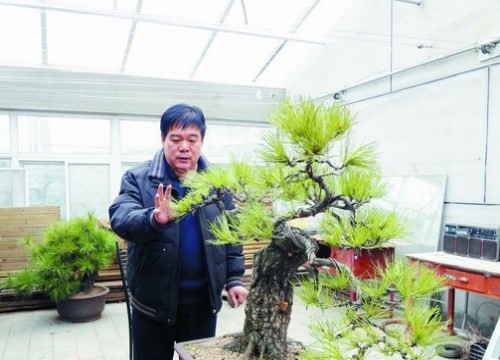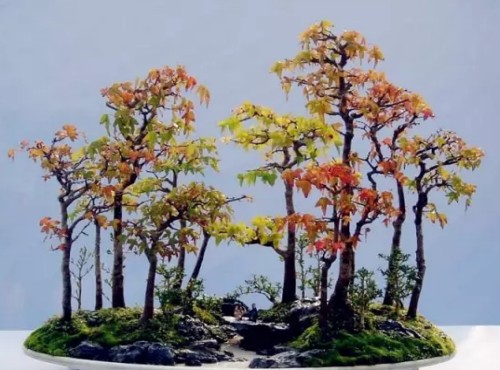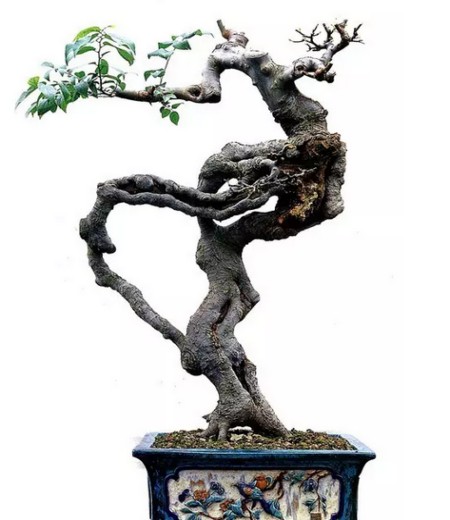Ten subjective consciousness tendencies should be abandoned in bonsai creation
The creation process of bonsai, because it is people's subjective consciousness acting on the objective entity, must run through a series of ideological activities. Under the conditions of the same region, economy and resources, there will be a large gap between different authors in terms of quality and the speed of progress. Among the many factors, an important one is that the bonsai creator is influenced by values, methodology and psychology. There will be an improper tendency to rely on light and heavy consciousness, which hinders the development of bonsai creation to a deeper and more refined aspect. It is mainly shown in the following aspects:

1. Important, light and small: pay more attention to commodity value and ignore artistic standard
Although the bonsai industry in China has made some restrictions on the height of the participating bonsai and the height of the pot: bonsai trees with a height of more than 120 cm will not be awarded. However, there are still many bonsai writers who are proud of being big and win by being big. Small bonsai are often overlooked. Think that it is not strong scene, momentum is not strong, commodity value is not high. Some of the judges of the exhibition despise the attitude of small bonsai and the orientation of measuring artistic level according to the value of market goods, and play a guiding role in the concept of important and light. As an artist, we should mainly evaluate the works from the level of artistic level. Bonsai is good and big is gratifying, small and fine should also be respected.
2. Heavy green and light bone: like evergreen plants and hate deciduous varieties
It should be understandable that evergreen bonsai can add greening to the cold winter and is loved by the general public. But as a bonsai writer, he should not have such a preference. On the contrary, bonsai works created with deciduous trees can enjoy different scenery of the four seasons with the change of seasons. That is, it is usually said that you can see both the leaves and the bones. Such as maple bonsai, spring buds sharp, summer shade such as cover, autumn red leaves like fire, winter iron Qiu branch. Its shape and content is much richer than that of evergreen trees. Some bonsai artists, in order to meet the needs of bonsai creation, even pick leaves and watch evergreen bonsai, which is called stripping for brocade.
3. Attach importance to the outside over the inside: prefer foreign rare varieties to local "local specialties"
"scarcity is precious". In the producing area of sparrow plum, some people think that sparrow plum is cheap. In the producing area of white wax, some people think that white wax is cheap. This is the understanding of the general public. As bonsai artists, it is not easy to think that varieties are cheap and abandon them. The so-called "cheap" is nothing more than its strong vitality and germination. This is precisely the excellent characteristics of bonsai plants, otherwise bonsai creation will be very difficult. We must not blindly pursue rare varieties and despise local varieties. It is a pity to turn treasure into waste.
4. Value yourself and despise him: attach importance to your own "baby bumps" and despise the successful works of others
Due to the psychological effect, some bonsai writers often prefer their own works watered with hard sweat. Look at your own work "A Flower" and other people's "tofu dregs". Some even "hate my house and my dog". Bring personal grudges to bonsai creation. From belittling the work to despising the author. I always think that I have a long seniority and win many awards, and I sniff at the mention of others, especially young writers. This is not conducive to learning from others to offset their weaknesses. Enrich your own treasure trove of knowledge. The fox is narcissistic. If you don't advance, you will fall back.
5. Emphasize similarities over differences: get used to old routines and reject new ones.
In the areas where bonsai art has a long history and more cultural precipitation, it is bound to form the same artistic style and technical characteristics. The traditional skill is to be familiar with the road. It is easy to be used over and over again and enjoy it. It is easy to make the work lack of novelty. When new techniques appear, it is not easy to be accepted, which attracts a lot of criticism. A large part of the reason is caused by the "inertia" of traditional ideas. In fact, successful innovative works, after the test of history, appear to be more robust and more vitality.
6. Heavy cutting and light binding: pay more attention to cutting and storing branches, giving up binding and forming
Bonsai techniques are well known in Jiangsu, Anhui and Zhejiang regions of China, and many binding methods are summarized. For modern people with a fast pace, many of their colleagues find it very time-consuming and time-consuming to follow the example of Lingnan. As the climatic conditions are different in different places, they should be treated differently. The average temperature in Lingnan is high, and plants grow fast, so it is a good method to cut off stems and store branches. If we only cut the bonsai from the middle to the north of our country, the forming time of bonsai will increase. Therefore, the combination of cutting and ligation appeared in the Central Plains and Hubei. You can get twice the result with half the effort. Learning advanced techniques should also be in line with local conditions and achieve the combination of cutting and binding.
7. Pay more attention to the picture and light the text: be satisfied with drawing the gourd according to the same pattern and refuse to create attentively.
Some bonsai writers like to collect bonsai pictures. Some even save the pictures of the magazine, and the articles are torn and discarded; some compare their works with those published in newspapers and periodicals, and those with the above numbers prove that their works are good works. Because the magazine wants to consider promoting and encouraging new authors and promoting the development of backward areas, it is inevitable that some immature works will be published. If you only copy the picture style, and lack of original and innovative works, just like copying paintings, you can't become a painter no matter how much you paint.
8. Heavy shape and light quality: indulge in the expression of form and ignore the pursuit of quality
Beginners of bonsai often indulge too much in whether the stump is old or not. Are there any holes? Is it like some kind of animal? It is easy to ignore the essence of the expression of social life and the author's thoughts and feelings in bonsai works. Do not realize that love in the scene, the blending of feelings and scenery is the real bonsai. Bonsai is like an animal, which is only one aspect of interesting potted plant modeling. The form must serve the content and coincide with the theme of the work. Form for the sake of form is not necessarily a good form, diligence and thrift to explore the depth of the situation, is the high-level pursuit.
9. Pay more attention to technology than art: pay more attention to the pursuit of techniques and lack of artistic research
In the process of basin creation, technology serves for art. Technique pursues the law of generality, while art pursues individual characteristics. The two are causality. Bonsai creation can not only stay in a variety of fixed "style", can not say that the branches are standardized, the basin has its origin. Always think that the combination of bonsai is OK, tree and stone bonsai technology content is not high is also wrong. We can only work on the original artistic style and on the performance of bonsai artistic conception. Absorb the nutrition of "regular", "natural big tree" and "wind" bonsai works of art in different periods. Achieve the development of both skills. Blaze new trails and keep moving forward.
10. Attach importance to reality and neglect reason: immerse yourself in practical exploration and despise theoretical discussion
Theory guides practice, and practice enriches theory. This is what everyone knows. But when we often come into contact with practice, it is easy to immerse ourselves in practice and despise theory. Some people think that there is too much controversy in theoretical articles, that "public argument is reasonable, women say it is reasonable". The author has the experience, the first reading of the theoretical article is a little different, read carefully, read several times to know the truth. It is the bonsai artists who discuss it actively, so that the problem can be debated more clearly and unified into the correct theory. On the basis of practice, the veterans of aesthetics and bonsai in China have summed up a lot of technical theories combined with practice and aesthetic theories, which can be applied to bonsai theory.
The above theories are not technical evaluation, but do not seem to have much to do with the material materials in bonsai works, such as trees, stones, pots, shelves, etc. However, we must see that human consciousness plays an active role, which is bound to influence the orientation of the development of bonsai art. No matter how good the craftsmanship and bonsai form are, if we are not willing to accept it, we will be turned away. As long as those who are interested believe that "good medicine tastes bitter, good advice goes against the ear", so as to avoid the suspicion of preaching, we all use artistic dialectics to correctly grasp the relationship between importance and importance, and the right degree of importance is the purpose of this article.
Time: 2019-05-23 Click:
- Prev

"four taboos" in the production and maintenance of jungle bonsai
Bonsai has a special display form called jungle style, this form of bonsai skillfully match mountains, stones and trees, showing the beauty of the jungle, just like a beautiful landscape painting, but jungle bonsai needs four taboos in the process of production and maintenance. One taboo across the board: the materials used in jungle bonsai are generally lobular shrubs
- Next

Bonsai art is a comprehensive plastic art of natural scenery.
Bonsai art creators use creative skills and reasonable layout to cultivate trees, flowers and plants with certain artistic shapes or mountains and rocks with different depths, widths, shapes, sizes, colors and textures in a variety of different depths, widths, shapes, sizes, colors and textures. to make it a landscape that mimics nature.
Related
- Fuxing push coffee new agricultural production and marketing class: lack of small-scale processing plants
- Jujube rice field leisure farm deep ploughing Yilan for five years to create a space for organic food and play
- Nongyu Farm-A trial of organic papaya for brave women with advanced technology
- Four points for attention in the prevention and control of diseases and insect pests of edible fungi
- How to add nutrient solution to Edible Fungi
- Is there any good way to control edible fungus mites?
- Open Inoculation Technology of Edible Fungi
- Is there any clever way to use fertilizer for edible fungus in winter?
- What agents are used to kill the pathogens of edible fungi in the mushroom shed?
- Rapid drying of Edible Fungi

